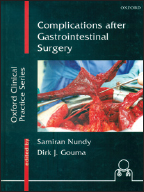Translate this page into:
Complications after Gastrointestinal Surgery
Corresponding Author:
Venkatramani Sitaram
Department of HPB Surgery, Tata Medical Center, Kolkata, West Bengal
India
vsr8287@icloud.com
| How to cite this article: Sitaram V. Complications after Gastrointestinal Surgery. Natl Med J India 2018;31:54-55 |
Complications after Gastrointestinal Surgery . Samiran Nundy and Dirk J. Gouma (eds). Oxford University Press, New Delhi, 2017. 399 pp, ₹2995. ISBN 0–19–947518–0.

I am pleased to write this book review. The book is edited by prominent surgeons in the field of gastrointestinal (GI) surgery who have published extensively. The team of authors is from all over the globe, from resource-rich to resource-poor countries. The target audience is the practising GI and general surgeons, gastro-enterologists, intensivists as well as trainees in these specialties. The book aims to provide a multi-disciplinary team approach to the care of the GI surgery patient who has not followed a ‘normal’ course after GI procedures.
The contents are divided into three sections: general aspects, general institutional issues and organ-specific problems.
The first section on general aspects of management of surgical complications is a ‘must read’ for all trainees in general surgery and GI surgery. It is comprehensive and the references are up to date. Programme directors of training courses would be well advised to shut their junior trainees in a room for a specified period of time till they (the trainees) have digested this section.
The second section on general institutional issues should be of interest to healthcare policy-makers. Interventions such as registries, checklists, centralization and audits are described by pioneers. The evolution of these interventions has been provided and makes for fascinating reading.
The third section is the organ-specific description of complications after GI surgical operations and is organized in four sections: oesophagus and stomach, intestines, liver, gallbladder and bile ducts, and pancreas. Some of the authors have added an overview of surgical treatment of specific diseases in addition to addressing recognition and treatment of complications. The coverage is comprehensive. The addition of treatment in resource-poor settings, the inclusion of laparoscopic operations and liver transplantation are bound to be helpful.
The layout of the book is attractive. The choice of a non-serif font with a bigger font size would have made it more so. The illustrations are good; the intraoperative pictures and radiological images have been well reproduced. Two things that I found commendable: each chapter can be read independently, the indexing is very good.
The book is large and is priced at ₹2995; the individual practising GI and general surgeon, gastroenterologist, intensivist as well as trainees in these specialties are unlikely to buy a copy. I am reminded of the adage: what is good is not cheap; what is cheap is not good! However, it should be in every departmental and institutional library of hospitals that cater to GI surgery patients. The fields of GI surgery, anaesthesia, intensive therapy and interventional radiology are rapidly changing. One hopes that subsequent editions of this book will appear fast enough to keep pace with change.
Fulltext Views
1,321
PDF downloads
10,767




